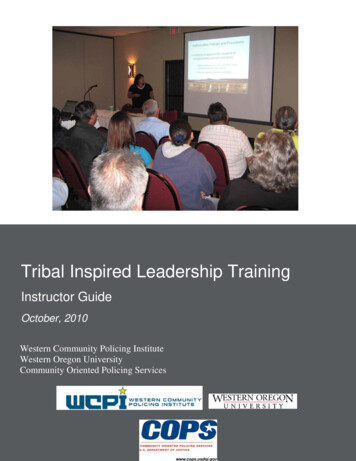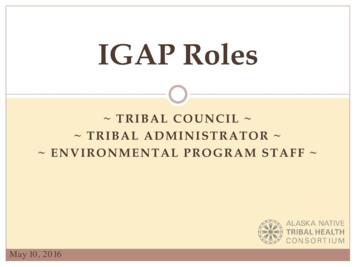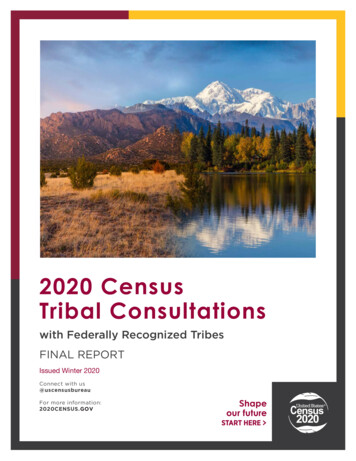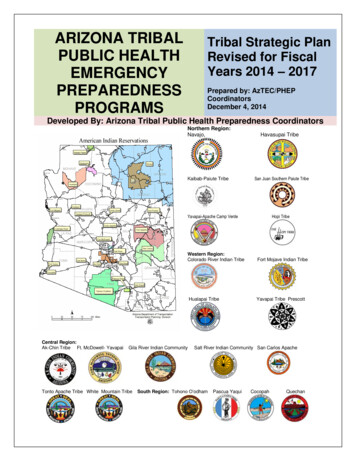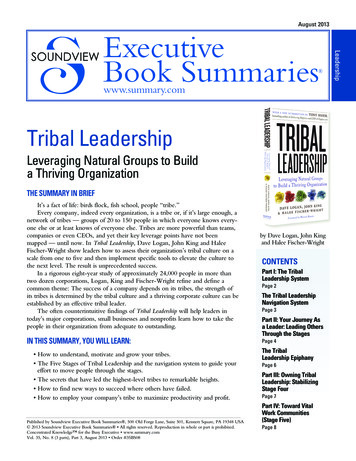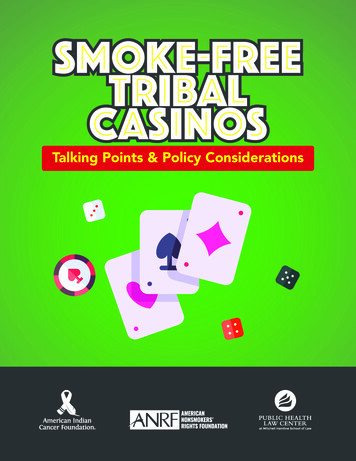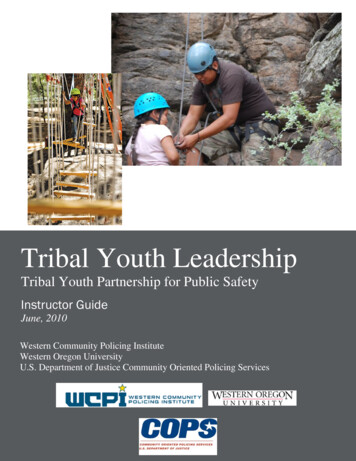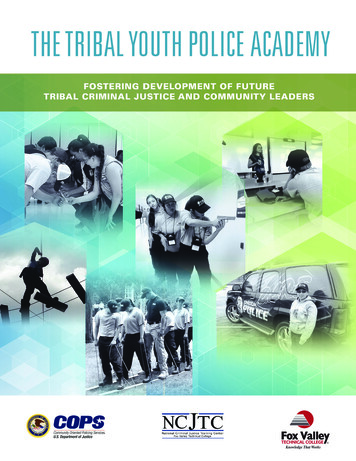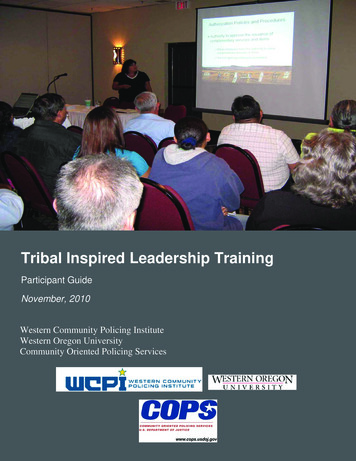
Transcription
Tribal Inspired Leadership TrainingParticipant GuideNovember, 2010Western Community Policing InstituteWestern Oregon UniversityCommunity Oriented Policing Services
Tribal Inspired Leadership TrainingParticipant GuideTable of ContentsMODULE 1: Introductions. 1Background: Course Provider, WCPI . 1Participant Introductions. 2Course Overview . 2Course Goal, Modules, and Objectives . 2Introduction to Technology. 5Introduction to Qwizdom . 5System Overview . 6Three Leadership Profiles . 9Leadership Wheel. 10Community Policing: Looking to Tomorrow. 14TILT in Review . 15Module 1 Wrap-Up. 17Module 2: Carrying Out Community Policing Principles: Defining andUnderstanding Leadership and Management Roles . 18Help Wanted Ad Exercise Part 1 . 20Leadership and Core Cultural Competencies. 21Understanding Culture . 21Historical Events . 22The Evolution of Leadership Theory and Practice . 27Peter Drucker: Concepts of Leadership. 28Evolution of the Knowledge Worker. 33The New Dynamics of the “Knowledge Worker” . 34Leadership and Management Compared . 36Leadership and Management Redefined. 38The Four Dimensions of the Leadership Test . 39Help Wanted Ad Exercise Part 2 . 42Wrap-Up .43MODULE 3: Leadership of Teams at Critical Times: The Relationship of TeamDevelopment and the Leader’s Role. 44Situational Leadership. 46Situational Leadership Principles. 56Leadership Wheel Exercise/Group Response .64Module 4: Tribal Inspired Leadership Skills: Primal Leadership and EmotionalIntelligence (EI). 67Page i
Tribal Inspired Leadership TrainingParticipant GuideTribal Challenge . 69The Physiological Capacity for Leadership: The Limbic System . 77Overview of the Limbic System . 77Influence, Communication, and Emotional Intelligence: The Essence of PrimalLeadership . 79Communication Analysis and Limbic Influence Exercise . 80Primal Leadership and Emotional Intelligence. 82The Essence of Primal Leadership . 84The Primal Leadership and Tribal Inspired Leadership Skills . 90Practicing Primal Leadership. 90Wrap-up. 96Module 5: Comprehensive Application of Homeland Security Strategies: TheTransformational Leader . 97Transformational Leadership. 100Elements of Transformational Leadership: Four Basic Steps for a. 106Transformational Leader . 106Transformational Leadership and the Moral Cause . 110Transformational Leadership Characteristics and Vision . 114The Pygmalion Effect and Transformational Leadership . 118Applying Transformational Leadership to your Leadership Challenge . 120Wrap-Up . 126Version 1 – November, 2010Page ii
Tribal Inspired Leadership TrainingParticipant GuideMODULE 1: IntroductionsTILT Course ProvidersSponsored by U.S. Department of Justice/Community OrientedPolicing ServicesAward #2009 HEWXK002Developed by Western Oregon University/Western CommunityPolicing InstituteTribal Inspired Leadership TrainingOctober, 20102Background: Course Provider, WCPIThis course is sponsored by U.S. Department of Justice/Community Oriented PolicingServices (COPS); and the grant award number is:2009 HEWXK002The author of this curriculum is the Western Community Policing Institute (WCPI).Western Community Policing InstituteFunded by the U.S. Department of Justice/COPSDelivering training since 1996Located at Western Oregon University in Monmouth, OR3Some background facts about WCPI are as follows: Funded by the U.S. Department of Justice, (COPS) and the U.S. Departmentof Homeland Security (FEMA), Responder Training.govLocated at Western Oregon University in Monmouth, OregonDelivering training since 1996 Course LogisticsCoffeeRestroomsPhone calls and pagersBreaks and mealsSeating arrangementSign-in rosterParticipant notebooks4October, 2010Version 1Page 1
Tribal Inspired Leadership TrainingParticipant GuideModule I: Introductions5Participant Introductions“Undercover Boss”What is important to your employees?promotes RetirementbiesHobFamilyLeadershipis .Course OverviewInteractive Scenario-basedTraining uses historical examples to examine leadership “Lastchapters of their lives have been written. We can look at theiractions based on historical events.”Designed for public safety and Tribal leadersRequires active participation and problem-solving InfluencingIntroduction Motivating Inspiring Being Credible Caring CompassionateHow well do you know your employees .68Course OverviewThis course is comprised of five modules. The course is challenge and scenario-based,requiring active participation and problem-solving. Participants will evaluate casestudies and shared experiences in the context of an executive’s leadership approach inimplementing and administering community policing in Indian country. In each module,participants examine and discuss the need for leadership and the importance ofcommunity policing. The concluding module provides final summary thoughts regardingidentified issues and provides a wrap-up for this course.Course GoalThis course is designed totrain and equip Tribalexecutives with the skillsnecessary to make leadershipdecisions for the purpose ofpreparing and implementingcommunity policing strategies.9Course Goal, Modules, and ObjectivesOctober, 2010Version 1Page 2
Tribal Inspired Leadership TrainingParticipant GuideCourse GoalThis course is designed to train and equip executives with the skills necessary to makeleadership decisions for the purpose of implementing and administering communitypolicing in their community.Course ModulesThe other modules in this course include: Carrying Out Community Policing Principles: Defining and UnderstandingLeadership and Management Roles.Successfully Integrating and Synchronizing Community Policing Principlesthrough Leadership: Situational Leadership.Community Policing Executive Leadership Skills: The Primal Leaders andEmotional Quotient (EQ).Comprehensive Application of Community Policing Principles: TheTransformational Leader.Module I – Learning ObjectiveTo introduce participants to the frameworkof the Tribal Inspired Leadership Trainingcourse10Module 1: Learning Objective (LO)At the conclusion of this module, participants will be provided an overview of the TILTcourse.Module I – Enabling ObjectivesAt the conclusion of the module, participants willbe able to:Identify the goals of the courseRecognize how course materials are to be utilizedin the Tribal Inspired Leadership TrainingUnderstand what leadership is and specificleadership approaches used in leadingorganizations11October, 2010Version 1Page 3
Tribal Inspired Leadership TrainingParticipant GuideModule 1: Enabling Objectives (EO’s)At the conclusion of this module, participants will be able to: Identify the goals of the courseRecognize how course materials are to be utilized in the Tribal InspiredLeadership Training CourseUnderstand what leadership is and specific leadership approaches used inleading organizationsAt the beginning and conclusion of each module,participants will be presented the Course’sEnabling Objectives. The Enabling Objectives arepresented for participants to achieve the TerminalLearning Objectives.Module I – Enabling Objectives12Module Enabling and Learning ObjectivesEnabling ObjectivesTo assist participants in successfully completing this course, each module identifiesenabling objectives that are presented throughout the training. At the beginning of eachmodule the enabling objectives are listed and reviewed. The enabling objectives aremechanisms to assist participants in achieving the learning objective for each module.Test Your Knowledge ExercisesAt the beginning and ending ofeach module you will bepresented a pre and post test ofyour knowledge. These tests willbe presented using the QwizdomResponse System.13Test Your Knowledge ExercisesAt the beginning and ending of each module participants will be presented a pre- andpost-test of participant’s knowledge. These tests will be presented using the QwizdomResponse System. The Test Your Knowledge Exercises are used to determineparticipants learning of each module’s curriculum.October, 2010Version 1Page 4
Tribal Inspired Leadership TrainingParticipant GuideSimulatorIntroduction to Technology LeadershipModels Historical Profiles Challenges Pay-offsThe TILT Simulator provides Historical Leadership Profiles throughoutthe presented scenario based challenges to provide leaders with help,advice, and commentary as they make their way through the simulation.The Profile serves as the virtual historical “bridge” to assist participantswith using the available tools and resources during the training. Theseinteractive scenarios are designed to develop a leader’s skills, byprompting leaders in the decision making processes in implementingcommunity policing.Introduction to TechnologyKey Terms1415Introduction to TechnologyThe TILT scenarios provide Historical Leadership Profiles throughout the course basedon specific Tribal leadership challenges. These scenarios are designed to helpparticipants develop leadership knowledge, skills, and abilities as they make their waythrough the course. The leadership profiles serve as the historical “bridge” to assistparticipants with using the available tools and resources during the training. Interactivescenarios are designed to develop a leader’s skills, by prompting leaders in decisionmaking processes before and during the implementation of community policingstrategies.Group Responder – QuizdomSystemQwizdom brings true interactivity to this training using thelatest innovations in wireless technology. The Quizdomsystem is integrated into the TILT curriculum andPowerPoint presentation to provide an opportunity foractive participation in the training activities.Introduction to Technology16Introduction to QwizdomThe Qwizdom Interact SystemQwizdom brings true interactivity to this training using the latest innovations in wirelesstechnology. The Qwizdom system is integrated into the TILT curriculum andPowerPoint presentation to provide an opportunity for active participation in the trainingactivities.The Qwizdom Actionpoint SystemQwizdom Participant RemoteOn/OffButtonSendButtonT True or YesF False or No1, 2, 3, 417October, 201018Version 1Page 5
Tribal Inspired Leadership TrainingParticipant GuideSystem OverviewQwizdom ComponentsQwizdom's Response Systemincludes a host, which plugs intothe instructor’s laptop or desktopUSB drive, teacher remote, andstudent remotes. The hosttransmits a radio frequency whichallows communication with theinstructor’s computer, the teacherremote, and student remote. ThisRF IEEE standard system helpsinsure robust, conflict-freeoperation and supports up to 1,000remotes at one time.The Qwizdom Participant Remoteprovides instant feedback toparticipants.The Qwizdom Instructor Remoteallows the instructor to presentslides, pause and play media, andpose a new question. Instructorscan instantly view a graph on theirremote's LCD screen or project theresults for the entire classroom.October, 2010Version 1Page 6
Tribal Inspired Leadership TrainingParticipant GuideC ClearT TrueF FalseorT YesF NoSendbuttonParticipant Remote:Test Your KnowledgeTest Your KnowledgeWhich of the following are typically characterized aselements of management?A.B.C.D.E.Test Your KnowledgeWhich of the following are challenges to communitypolicing?Which of the following are key elements of communitypolicing leadership?Task orientedBig picture focusBudget orientedA&CAll of the aboveA.B.C.D.E.Recruitment, hiring, and retentionDisengaged communitiesFunding shortfallsPoor collaboration between local governmentagenciese) All of the abovea)b)c)d)Leading peopleLeading changeBuilding coalitionsA&CAll of the above192021Test Your Knowledge Exercise1. Which of the following are typically characterized as elements of management?a)b)c)d)e)Task orientedBig picture focusBudget orientedA and CAll of the aboveOctober, 2010Version 1Page 7
Tribal Inspired Leadership TrainingParticipant Guide2. Which are key elements of homeland security leadership?a)b)c)d)e)Leading peopleLeading changeBuilding coalitionsA and CAll of the above3. Which of the following are challenges to community policing?a)b)c)d)e)Recruitment, hiring, and retentionDisengaged communitiesFunding shortfallsPoor collaboration between local government agenciesAll of the AboveTILT and Leadership in Community Policing Remarkably ValiantTILT and the Leadership ChallengesA lack of community trust.A community sense there is little accountability.Citizen apprehension to work cooperatively with public sectororganizations.Leveraging resources in responding to the effects of local economicdistress. Dealt a “bad hand” Study their lives Study their History Role models for our lives Pieces of personality I want We will “all” be given opportunitiesBill Westfall “What a pity if the moment would findus unprepared”22TILT and Leadership in Community PolicingLeaders are presented opportunities in their careers to demonstrate their knowledge,skills, and abilities (KSA’s) when faced with challenges. These include communityspecific challenges that can range from a lack of community trust in government; asense there is little government accountability; citizen apprehension to workcooperatively with public agencies; public safety agency resistance to embracecommunity policing; to leveraging community agencies in responding to the effects oflocal economic distress on public governance. For the purposes of this trainingovercoming these factors comprises of what can be referred to as the leadershipchallenge. In this course you will be introduced to historical leadership figures, thechallenges they faced, and the outcome of their actions. They were chosen todemonstrate the leadership knowledge, skills, and abilities they employed when facingparticular challenges. These historical figures are studied for a variety of reasons(Westfall interview) because they were: “Remarkably valiant”“Dealt a bad hand”“Study their lives”“Study their history”October, 2010Version 1Page 8
Tribal Inspired Leadership TrainingParticipant Guide “Role models for our lives”“Pieces of personality I want”“We will “all” be given opportunities”“What a pity if the moment would find usunprepared”The leadership figures selected for this program will highlight the specific challenges of: Knowing people and what their specific needs are – Situational LeadershipPreservation – Primal LeadershipSharing a vision – Transformational LeadershipThree Leadership Presentations Chief Gall Chief Tecumseh Wilma MankillerTILT and Leadership in Community Policing23Three Leadership Profiles Chief Gall Tecumseh Wilma MankillerThe “Indispensable Leader” Fallacy“leadership must move from theidea of a leader, a person, toleadership, a competency, thatcan and should be exhibited byall members of an organization.”Love & Estanek 2004“One-man rule”“No institution can possibly survive ifit needs geniuses or supermen tomanage it.”25Drucker,Drucker, 1946The “Indispensible Leader” Fallacy “No institution can possibly survive if it needs geniuses or supermen tomanage it.”“One-man rule”October, 2010Version 1Page 9
Tribal Inspired Leadership TrainingParticipant GuideThe “Indispensable Leader”- PervasiveLeadership“Pervasive leadership isindividually generatedrelationships and actionsamong members throughoutan organization focused onstruggling together toinfluence and promoteorganizational learning andaccomplish positivechanges to benefit thecommon good.”26 History of the rustTeam “You cannot drag people”The Invisible Leader - "By design and bytalent ."William Fenton Russell – Boston CelticsHonors:Elected to Naismith Basketball, Basketball Hall ofFame (1975); NBA champion (1957, '59, '60, '61,'62, '63, '64, '65, '66, '68, '69); NBA MVP (1958, '61,'62, '63, '65); All-NBA First Team (1959, '63, '65);Eight-time All-NBA Second Team; NBA AllDefensive Team (1969); 12-time NBA All-Star(1958-69); All-Star MVP (1963); One of the 50Greatest Players in NBA History (1996); Olympicgold medalist (1956).wrote basketball player Bill Russell of histeam, the Boston Celtics, "(we) were a teamof specialists, and like a team of specialistsin any field, our performance depended bothon individual excellence and on how well weworked together. None of us had to strain tounderstand that we had to complement eachother's specialties; it was simply a fact, andwe all tried to figure out ways to make ourcombination more effective.VIDEO: Bill Russell and Leadership272829The Invisible Leader"By design and by talent ” wrote basketball player Bill Russell of his team, the BostonCeltics, " (we) were a team of specialists, and like a team of specialists in any field,our performance depended both on individual excellence and on how well we workedtogether. None of us had to strain to understand that we had to complement eachother's specialties; it was simply a fact, and we all tried to figure out ways to make ourcombination more effective.The Leadership Decision WheelTransformationalServant to his/her peopleSuccess of purpose drivenGives eStrong egoSpiritualEldersNORTH: WhitePhysicalBirthMental AspectWisdom & LogicCREATORPhysical AspectIntrospection &Determine EnergyIllumination &EnlighteningSunSelf ManagementSelf AwarenessWarmthYellowSOUTH: RedLightWaterAutumnSeedsSpiritual s EnergyBlueEAST: YellowPrimalGrizzlyWEST: shipManagementAnimalsReceive eopleCenteredSocialAwarenessPlantsGives EnergyLovelnaat ioSituEmotion al AspectRedSummerTrust & InnocenceMentalTeenagersRed manFlexibleAdaptiveBuffaloDirectiveSupportiveThe Leadership Decision Wheel (Leadership Wheel)Through out this course, participants will have the opportunity to use the LeadershipWheel as a tool for enhancing their leadership decision making abilities. ByOctober, 2010Version 1Page 10
Tribal Inspired Leadership TrainingParticipant Guideunderstanding the principles of the Leadership Wheel, Tribal leaders can use theLeadership Wheel as a tool to help them make more effective leadership decisions.The Leadership Wheel consists of four quadrants (see below); three of the quadrantsrepresent different leadership styles that will be presented in class. These three stylesare Situational, Primal, and Transformational. The fourth quadrant represents theconcepts of leadership and management and can be used by participants to frame thedifferences between the two.Leadership WheelLeadership gtChallengesChallengesChallengesChallenges Rapid ChangeUnanticipatedCircumstances Knowing my peoplesneeds How do I lead them Declining culturalvalues Preserving Tribalcultural values Stoppingorganizationalparalysis Inspiring others Organizationalparalysis Overcoming limitedexpectations Overcomingdistractions andobstacles Leadership vs.management Official and unofficialleadership Formal and informalleadershipLeadership cteristicsCharacteristicsCharacteristics Flexible Adaptable Prescriptive Guidance Practical EmotionalIntelligence GoodCommunicator Inspirational Resonance Healthy egos Purpose driven Forward thinking Motivating Inspiring Honesty Integrity Visionary Problem/ Solving Big picture Directing Flexible Adaptable Prescriptive Guidance Practical EmotionalIntelligence GoodCommunicator Inspirational Resonance Healthy egos Purpose driven Forward thinking Motivating InspiringLeadership/MgtCharacteristics Honesty Integrity Visionary Problem/ Solving Big picture DirectingLeadership Payoff Adaptive Meets Challenge Recognizes needs Self-management Developing the vision Self-awareness Selling the vision Relat Finding the wayionship Leading the chargemanagement Social awarenessLeadership MgtPayoff Right thing Right time Right way Right reasonSituationalChallenges Rapid ChangeUnanticipatedCircumstances Knowing mypeoples needs How do I leadthemLeadership WheelPrimalTransformationalChallengesChallenges Decliningcultural values PreservingTribal culturalvalues Stoppingorganizationalparalysis Inspiring others Organizationalparalysis Overcominglimitedexpectations Overcomingdistractions andobstaclesLeadership/MgtChallenges Leadership vs.management Official andunofficialleadership Formal andinformalleadershipFigure 1.1October, 2010Version 1Page 11
Tribal Inspired Leadership TrainingParticipant GuideSituationalCharacteristics ership ristics EmotionalIntelligence GoodCommunicatorInspirational Resonance Healthy egosPurpose drivenForward istics HonestyIntegrityVisionaryProblem/Solving Big picture DirectingFigure 1.2SituationalApproach DirectiveSupportiveAutocraticDemocraticLeadership WheelPrimalTransformationalApproachApproach Stability Guidance Assuredness Servant to people Selling a vision Inspiring andmotivating to actionLeadership MgtApproach e 1.3SituationalPayoffLeadership WheelPrimalTransformationalPayoffPayoff Adaptive Self MeetsmanagementChallenge Self-awareness Recognize Relationships needsmanagement Socialawareness Developing thevision Selling the vision Finding the way Leading the chargeLeadership MgtPayoff Right thingRight timeRight wayRight reasonFigure 1.4October, 2010Version 1Page 12
Tribal Inspired Leadership TrainingParticipant GuideThe Dynamics of Community PolicingLeadershipKey Dynamics Leadership and management areinexorably linked Leadership is the ingredient thatactivates and maximizes resources Leadership is the quintessentialforce multiplier35The Dynamics of Community Policing LeadershipApplication to Tribal Inspired Leadership: Effective leadership is a criticalcomponent of community policing at every level of both the public and private sectors.Through effective leadership that incorporates sound management practices, individualscan help create a culture of community policing that is absolutely vital to ourcommunity’s safety and security.The Expectations of Community PolicingLeadershipCommunity policing is a philosophy that promotesorganizational strategies, which support the systematicuse of partnerships and problem-solving techniques toproactively address the immediate conditions that give riseto public safety issues such as crime, social disorder, andfear of crime.http://www.cops.usdoj.gov/36 Recognizing the complexity of community policing, what does a leaderneed in terms of knowledge and proficiencies?Would you be able to do your job if you were a great leader without anyknowledge related to community policing?Application to Tribal Inspired Leadership: This section identifies specific technicalproficiencies and specialized knowledge that are needed for community policing leadersand decision makers.Principles of Community Policing: Recruitment, hiring, retentionReinforcing Community PolicingInability to institute changeDisengaged communitiesFunding shortfallsPolitics of public safetyPoor collaboration betweengovernment agenciesPolicymakingMaking the case for “CommunityPolicing”Community Policing Leadership –The AssurancesPrinciples of CommunityGovernance: Partnerships among municipalagenciesPartnerships with the communityCollaborative problem-solving effortsOrganizational changeLeadership is “Everyone’s Business”“The large corporation is in no way different from any army: itmust have the equipment buy also, as in the army, equipmentis of no avail without the functional organization of human effort.And like the army or like any other social institutions, the thingsthat really count are not the individual members but therelations of command and responsibility among them.”“Leadership is not about organizational power orauthority. It’s not about celebrity or wealth. It’snot about the family your are born into. It’s notabout being a CEO, president, general, or primeminister. And its definitely not about being ahero. Leadership is about relationships, aboutcredibility, and about what you do.”Drucker, Concepts of the CorporationThe Dynamics of Community PolicingLeadershipOctober, 20103738Version 1Kouzes & Posner 200739Page 13
Tribal Inspired Leadership TrainingParticipant GuideCommunity Policing: Looking to TomorrowChallenges: What are the challenges to traditional community policing? Recruitment, Hiring, and RetentionReinforcing Community PolicingInability to Institute ChangeDisengaged CommunitiesFunding ShortfallsPolitics of Public SafetyPoor Collaboration Between Local Government AgenciesPolicymakingMaking the Case for “Community Policing”Advancing Community Policing Through Community Governance: A FrameworkDocument.This document defines community governance as “a philosophical approach to localgovernance in which municipal agencies, city leaders, and the community (e.g.,nonprofit and community-based organizations, individuals, and businesses) viewthemselves as partners and collaborate to address community problems and improvethe overall quality of life.” (Diamond and Weiss, p. 3) Diamond and Weiss note,“Community policing is a philosophical approach to policing; it is not a program or set ofprograms or tactics.” The elements of community governance include: Partnerships among municipal agenciesPartnerships with the communityCollaborative problem-solving effortsOrganizational changeWhat do you believe it takes to be an effective community policing leader?Application to Tribal Inspired Leadership:This section assists participants in understanding the relationships that exist betweeneffective leadership and effective management. It also helps participants understand thefour mission areas of community policing and basic risk management principles asrelated to prevention.October, 2010Version 1Page 14
Tribal Inspired
on specific Tribal leadership challenges. These scenarios are designed to help participants develop leadership knowledge, skills, and abilities as they make their way through the course. The leadership profiles serve as the historical "bridge" to assist participants with using the available tools and resources during the training. Interactive
